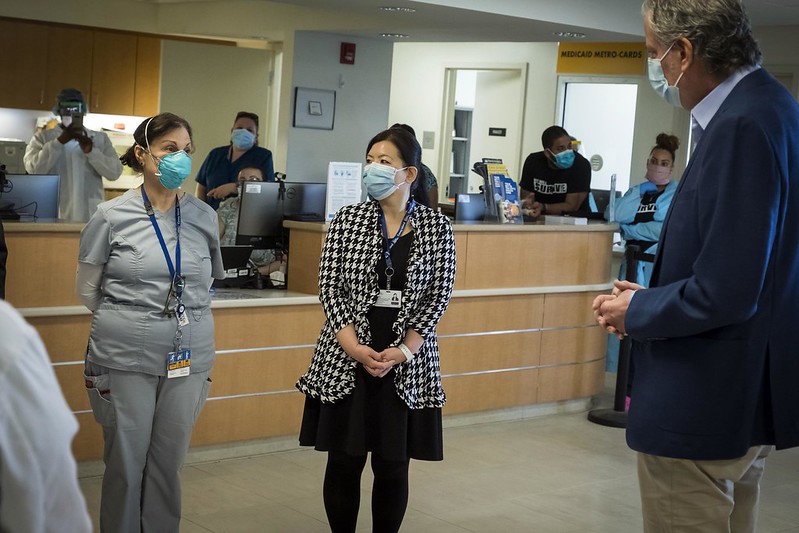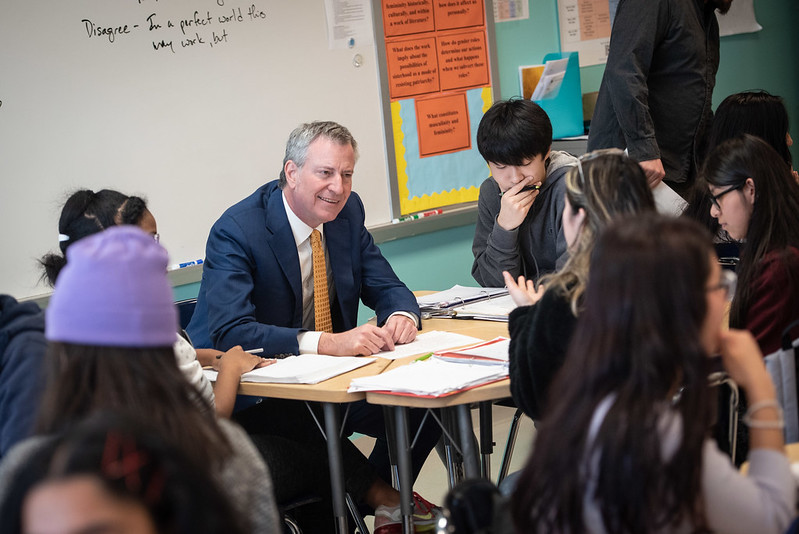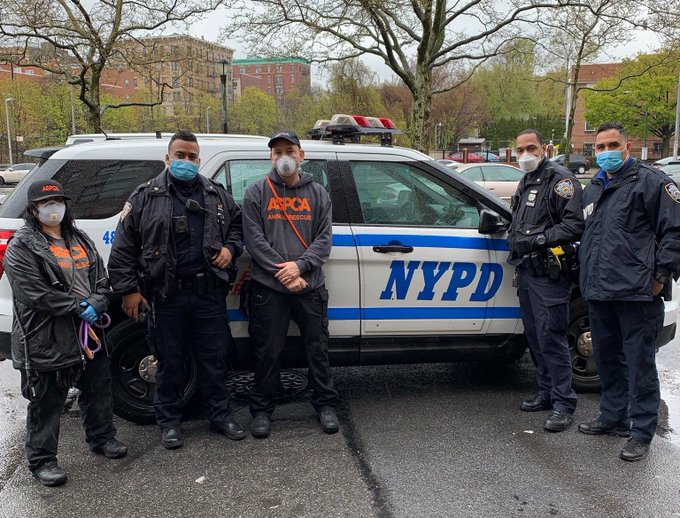Solving the School Nurse Crisis Before Schools Reopen

Mayor de Blasio talks with nurses (photo: Ed Reed/Mayoral Photography Office)
Long before COVID-19, New York City schools were dealing with a public health crisis: a lack of full-time nurses. Despite operating more than 2,000 schools, the city only employs around 1,400 nurses. It outsources others through private companies, wasting precious tax dollars, more than $100 million per year, on profiteering vendors rather than investing in the nursing staff that our schools need. And that they will need even more once schools open back up.
On Thursday evening, the Panel for Educational Policy approved two emergency contracts to hire additional private nurses for schools, a move that city leaders say is needed to ensure that enough nurses will be available to open schools. However, this approach will only perpetuate a major problem that has been developing for nearly a decade. New York City schools must employ at least one full-time nurse in each school building.
In March, Mayor de Blasio made a promise to have a nurse in each school, but he brought in 85 nurses to assist in filling more than 400 vacancies. It made no progress toward the level of health care that our schools need.
New York City leaders keep sweeping this problem under the rug. With a shortage in the nursing profession, two employment castes along with two union contracts, and an increasing need for medical care within the student population, the work has become one of those complicated issues that is often treated with equal parts passion and paralysis in the offices of elected officials.
Back in late 2018, me and my colleagues from the Community Education Council, District 3 (CEC3), held a public meeting where Dr. Roger Platt, from the Office of School Health, explained the employment structure to Upper West Side and Harlem parents. We couldn't believe how flawed the organization seemed to be, to have roughly 2,000 schools - public, charter, parochial, and private - serviced by only 500 nurses who are employed by the Education Department and 900 nurses employed by the Health Department. This pool of 1,400 “full-time” or permanent nurses had to be supplemented by hundreds of other nurses who were hired via private vendor contracts.
Union contract agreements complicated the matter further, because as it was later discovered, only the Department of Education (DOE) nurses are really full-time. With the support of the United Federation of Teachers (UFT), these coveted nursing positions enjoy salaried work with benefits and pension, working the school year like most teachers. The Department of Health (DOH) nurses are permanent employees but paid an hourly wage (not equal to that of DOE nurses) and overtime. Some, plus DOH nursing supervisors, are also expected to work throughout the year, and their benefits are not as robust as those of the DOE nurses. These nurses are represented by DC37.
Looking to private nursing companies to staff schools, so as not to deal with the full-time employment issue, seems to be the main driver for so many agency contracts, but there are serious problems with this rationale. For starters, taxpayers are paying for the profits made by the private vendors, who don’t typically pay their nurses all that well. Outsourcing essential government jobs wastes money and also falls short on the quality of work that is needed.
More importantly, unlucky schools without a full-time nurse often don't know who will be serving their students. Often these are the schools with higher rates of asthma, diabetes, and other conditions that demand medical attention for students. Some schools in Northern Manhattan and the South Bronx have asthma rates as high as 40%. Other health conditions are also on the rise, many of which require daily care such as injections, catheterizations, and medication administration.
Contract nurses sent in as subs also don’t even have access to the “Automated Student Health Record” (ASHR) system. When they see a sick student, they have to rely on accurate written records, if any. They complete a written document of the visit, which technically should be entered into ASHR but isn’t. ASHR also informs New York City’s “syndromic surveillance” capabilities, a database of citywide disease information that is more important than ever.
Before the pandemic, more than 50 New York City schools operated without a nurse on staff at any given day. This led principals to make more 911 calls, taxing our emergency response system. They also had to place calls to parents with children who require skilled nursing care, leading to higher student absence rates. Some parents simply pulled their children out of the DOE and resorted to homeschooling.
To nursing supervisors, this patchwork system has meant a persistent shifting around of schedules, absences, and other issues related to working with independent contractors. It held up the heavy data flow of information related to medication administration forms, because they too get entered into ASHR. But this particular task is a constant reminder of how flawed the school nurse structure is for student care.
New York City has not prioritized school nurses for years. COVID-19 has shown us all how essential our school nurses are and will even more so when school buildings open again. The Panel for Educational Policy vote on private vendor contracts highlights the city’s reluctance to deal with the problem fairly and equitably. But there is still time to make progress on this issue.
City leaders can bring the right people together to restructure the employment model and create a pipeline for the hiring process. We need a school system that truly serves our children, and that means that every school should have a full-time school nurse when we resume normal operations in the fall.
***
Kim Watkins is a Harlem parent, president of Community Education Council, District 3, and a founding member of Parents Supporting Parents. On Twitter at @kimwatkinsnyc.
***
Have an op-ed idea or submission for Gotham Gazette? Email This email address is being protected from spambots. You need JavaScript enabled to view it.
How is New York City Going to Safely Open Its Many Overcrowded Schools, Like Mine?

Mayor de Blasio has major school decisions to make (photo: Michael Appleton/Mayor's Office)
We’re looking at a possible school re-opening this September. I can’t wait to go back. Remote learning is better than nothing, but it’s no substitute for a live classroom. In a live classroom, I can see what students are doing. I can check their work in real time and quickly offer tips for improvement. I can urge students away from sleeping or fiddling with electronic devices.
Now I’m reduced to looking at a bunch of avatars. Who knows what the kids are doing behind them? Not me, at least. I’ve become the teacher who just sits at the desk and never ventures out to see what’s going on. In fairness, my students are in their homes and what goes on in them is none of my business. While I’ve been doing presentations lately to encourage them to come out from behind the avatars, they could have many reasons not to reveal themselves.
Of course, like my colleagues, I do the best I can. As much as I want to get back to my real job, I’m quite concerned about what a return will look like. Lots of schools are overcrowded, though not all of them quite as badly as ours.
As the most requested school in the city, Francis Lewis High School in Queens has become a victim of our own success. Mayor Bloomberg’s Department of Education overloaded us to 4,600 students, but made an agreement with the United Federation of Teachers (UFT) to reduce enrollment. We were down to almost 4,000 students when Mayor de Blasio broke the agreement and loaded us right back up again.
We’re the largest school in Queens. As far as I know, at well over 200% capacity, we’re the most overcrowded school in the city. Assuming there’s no COVID-19 vaccine by September, I’m quite concerned about what returning will look like. Even if we make two end-to-end schedules, or have half the student body come in every other day, we’ll still have a building, conservatively, at roughly 105% capacity.
Given that, how would we achieve anything resembling social distancing? Could we stagger hall passing so that only half the students are out at a time? Could we even get thousands of teenagers to respect social distancing?
It’s really hard to say. We’re at the mercy of the Mayor and New York City Department of Education, not known for thorough consideration of pressing issues. For example, we’ve long known that classes of 34 students are less than optimal for student learning. This notwithstanding, during contract negotiations one of Mayor de Blasio’s hired hands told me the city had no interest in lowering class sizes. And now the question has even more urgency: How are we going to keep students safe if we continue to pack them in like sardines?
The UFT has made health and safety of students and staff a prime consideration for school reopenings moving forward. I’m grateful to be in a union that can stand up to management. This is particularly relevant when said management saw fit to keep overcrowded schools open even as Broadway curtains were closed. I will never, ever understand why people with $800 Hamilton tickets were too fragile to go out while 1.1 million students and the many tens of thousands of staff who serve them were all crushed and pushed and shoved and mushed on subways and buses and in the halls of overcrowded buildings.
Dozens of my brother and sister unionists are now dead. Many more are, or have been, quite sick. Who can even conjecture how many of us are walking around asymptomatic and infecting others? No one can dispute that dumping us all back into a hugely overcrowded building will cause even more sickness and death.
We now know that overcrowding and huge class sizes are not only learning issues, but health issues as well. For the sake of our children, for the sake of our families, and yes for the sake of teachers and other staff, we need to stop acting like overcrowding is acceptable treatment for New York City’s children. We need a real reopening plan to help real students. Their safety is paramount.
If Mayor de Blasio wishes to salvage what reputation he has left after closing the schools too late, it behooves him to deal with this head on. If we can find space when Amazon needs it, we can find it for our students, too.
***
Arthur Goldstein is an ESL teacher and UFT chapter leader at Francis Lewis High School. He serves on the UFT Executive Board and blogs at nyceducator.com. On Twitter @TeacherArthurG.
***
Have an op-ed idea or submission for Gotham Gazette? Email This email address is being protected from spambots. You need JavaScript enabled to view it.
Policing During a Pandemic: The Mayor Must Alter City's Approach

Policing during a pandemic (photo: @NYPDnews)
As we face one of the most pressing global health crises in over a century, New York City continues to use ineffective and, at times, discriminatory policing practices. For evidence that they aren’t working, one need look no further than the controversy regarding the de Blasio administration’s clumsy attempt to manage the crowd attending the funeral of Rabbi Chaim Mertz, a revered leader of Williamsburg’s Orthodox Jewish community. For even more recent proof, there's the disturbing video of an incident in lower Manhattan that started with officers policing social distancing and ended with a violent, seemingly unprovoked assault on, and arrest of, an innocent bystander.
The city maintains it is following the recommendations in the Centers for Disease Control and Prevention’s Guidelines for Coronavirus Prevention, the first of which is to follow “tips for social distancing from authorities.” However, giving the responsibility to NYPD officers and expecting that they will safely and effectively administer these new guidelines is not an effective solution. Here are some of the specific problems with this approach:
NYPD officers still resort to tactics that their training and own inclinations lead them to; they use force and intimidation to resolve problems at hand—a “might makes right” approach that is exactly the wrong way to achieve the community’s compliance with social distancing requirements.
Officers must break social distancing rules to issue a summons or make an arrest. This activity puts both officers and members of the public at risk.
Over 7,000 of the 36,000-member police force have called in sick since the pandemic began affecting New York, and more than 2,000 police officers have returned to work after “recovering from the virus.” As we learn more about how the coronavirus spreads and how symptoms do not show up for several days if at all in some people who carry the virus, we cannot be sure that more NYPD officers aren't sick than what has been reported.
NYPD arrest and ticketing practices disproportionately target low-income black and Hispanic communities. These practices create a greater risk for vulnerable communities during the pandemic.
The fines officers issue for social distancing violations range from $500-$1,000, an unreasonable burden, especially for the poor New Yorkers of color who are and will be experiencing the brunt of police actions.
On the other hand, we offer suggested practices that will make compliance with social distancing a safer and fairer process for all our communities:
End the use of the NYPD (and other police forces) as the enforcers of state and city social distancing orders.
Enlist community leaders and local clergy with the responsibility to achieve compliance with social distancing and other relevant rules and to work with their communities on a collaborative basis to ensure safety without involving punitive law enforcement practices.
As examples of the kind of community leaders who can perform social policing effectively, the city should look to the credible messengers who carry out the central work of the Cure Violence programs that are located in neighborhoods throughout the city and that have proven successful in working with young gang members to significantly reduce local conflicts.
Furlough some NYPD officers to reduce the number of cops on the street and to curtail the spread of the virus.
More effective and benign, these measures will help achieve the desired goal: a safe, just, and healthy city for all New Yorkers. Now more than ever, it is imperative that we rely on our communities to protect and care for their neighbors. We are the ones who keep us safe. It is people, not police, who will achieve that critically important goal.
***
Bob Gangi is the executive director of PROP, the Police Reform Organizing Project, where Luke Messina is associate director; Marzian Alam is policy analyst; and Mikaela Berry is communications coordinator. On Twitter @PROPNYC.
***
Have an op-ed idea or submission for Gotham Gazette? Email This email address is being protected from spambots. You need JavaScript enabled to view it.




